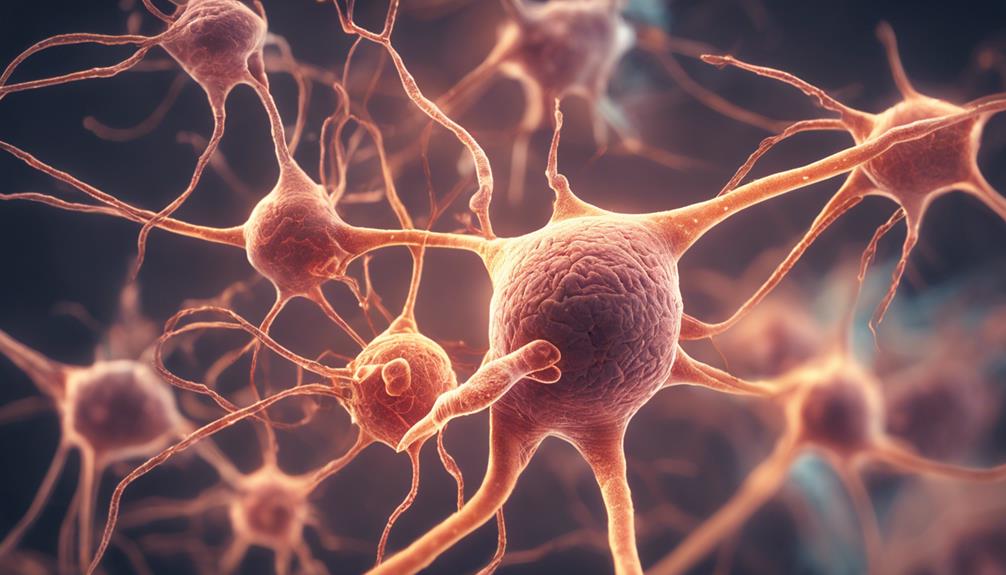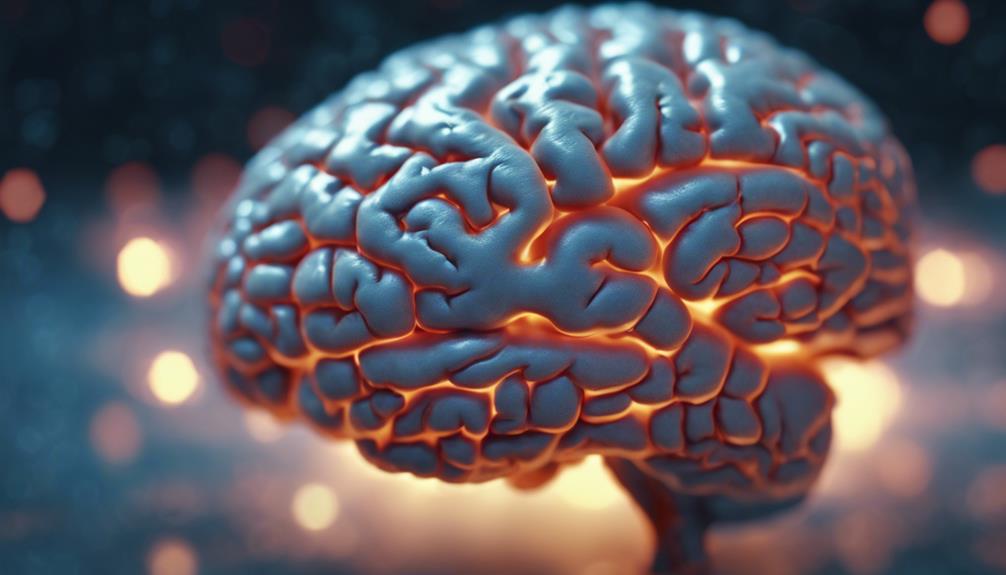Recent studies have identified a specific type of brain cell, characterized by the RIT2 gene, that undergoes significant decline in individuals with Parkinson's disease. These findings provide vital insights into the mechanisms implicated in the progression of this condition. The unique neuronal population in the substantia nigra, with distinctive genetic profiles linked to RIT2 expression, plays a key role in the disease process. Understanding the decreased expression of RIT2 in advanced Parkinson's stages offers valuable implications for the development of new medications and diagnostic biomarkers. Further exploration of these specific brain cells may lead to improved therapeutic interventions.
Key Takeaways
- Specific dopamine neurons with RIT2 gene decrease in Parkinson's.
- Genetic profile sets vulnerable neurons apart.
- Substantia nigra neurons show reduced RIT2 gene in advanced stages.
- Insights into cell-to-cell communication changes in Parkinson's.
- Potential for targeted therapies based on vulnerable neuron identification.
Identification of RIT2 Gene in Neurons
In neurons of the substantia nigra, researchers identified a unique group marked by the activated gene RIT2. This discovery holds significant implications for understanding Parkinson's disease.
The expression of the RIT2 gene was observed to decrease in the later stages of Parkinson's, hinting at its involvement in the disease's progression. By pinpointing these RIT2-expressing neurons, scientists were able to create a detailed atlas of gene expression specific to the substantia nigra.
Through studying these neurons, valuable insights into alterations in cell-to-cell communication associated with Parkinson's disease were obtained. Moreover, the identification of this distinct neuronal population opens up promising avenues for the development of new treatments and biomarkers for Parkinson's.
Understanding the role of the RIT2 gene in these neurons provides a foundation for further research aimed at unraveling the complexities of Parkinson's disease and potentially paving the way for more effective therapeutic interventions.
Substantia Nigra Neuronal Population

Among the neuronal populations identified in the substantia nigra, a unique group characterized by the expression of the activated gene RIT2 stands out. Through single-nucleus RNA sequencing, researchers pinpointed this distinct neuronal population within the substantia nigra.
These neurons, expressing the RIT2 gene, exhibit a specific genetic profile setting them apart from other cell types in the region. The identification of this specialized neuronal population has provided vital insights into the intricate cellular composition of the substantia nigra. Additionally, the presence of the RIT2 gene in these neurons serves as a notable feature that differentiates them from surrounding cells.
Decreased Expression in Parkinson's Disease

A thorough reduction in the expression of the gene RIT2 is observed in a distinct group of neurons in advanced Parkinson's disease. This decrease in RIT2 gene expression was identified through an extensive analysis of gene expression patterns in over 315,000 cells from the substantia nigra.
The study not only pinpointed the reduced RIT2 expression but also facilitated the creation of a detailed atlas of single cells within the substantia nigra, emphasizing the specific neuron population affected. Understanding the alterations in RIT2 expression offers valuable insights into the changes in cell-to-cell communication that occur in Parkinson's disease.
These findings have significant implications for the development of new medications targeted at the unique neuron population associated with Parkinson's. Additionally, the discoveries may pave the way for the identification of novel diagnostic biomarkers for Parkinson's disease, enhancing early detection and potentially improving treatment outcomes for individuals affected by this neurodegenerative condition.
Potential for New Medications

With the identification of a unique group of neurons in the substantia nigra characterized by the activated gene RIT2, new possibilities for developing medications specifically targeting Parkinson's disease are emerging. This discovery sheds light on a potential avenue for creating novel drugs that could target this specific neuron population affected in Parkinson's patients.
By focusing on medications that can interact with the RIT2 gene or the neurons it regulates, researchers may be able to develop more effective treatments that directly address the underlying causes of the disease. Additionally, the identification of this neuron population opens up the potential for using specific biomarkers associated with RIT2 expression as indicators for disease progression and response to treatment.
This could lead to the development of diagnostic tools that enable earlier detection of Parkinson's and better tracking of the disease's advancement. The insights gained from studying these neurons offer promising prospects for the development of medications tailored to address the unique characteristics of Parkinson's disease.
Clinical Biomarkers for Diagnosis

Identifying clinical biomarkers for diagnosing Parkinson's disease presents an important opportunity to enhance early detection and disease progression monitoring.
Recent research utilizing single-nucleus RNA sequencing revealed a distinct cluster of neurons in the substantia nigra characterized by the activated gene RIT2. Surprisingly, the expression of RIT2 was observed to decline significantly in advanced stages of Parkinson's disease.
By analyzing data from this study, scientists were able to construct an atlas of individual cells within the substantia nigra, illuminating specific changes at the cellular level. These findings provide valuable insights into the alterations in cell-to-cell communication that occur in Parkinson's disease.
Additionally, the identification of gene RIT2 and other potential biomarkers signifies a promising avenue for developing clinical tools to aid in the diagnosis and monitoring of Parkinson's disease progression. This research underscores the importance of investigating cell-specific changes to advance our understanding of this complex neurodegenerative disorder.
Insights for Ongoing Research Efforts

Insights gleaned from the identification of the unique cluster of neurons marked by the activated gene RIT2 in the substantia nigra are driving ongoing research efforts in understanding Parkinson's disease. Researchers are focusing on unraveling the role of these specific brain cells linked to the gene called RIT2, particularly in the context of Parkinson's disease.
Some key areas that are being explored include:
- Understanding the specific functions and characteristics of these types of dopamine-making neurons.
- Investigating how the expression of the RIT2 gene influences the survival and activity of these neurons in Parkinson's disease.
- Exploring the potential implications of these findings for developing new therapeutic opportunities.
- Utilizing the data to identify novel targets for intervention and potential clinical biomarkers for diagnosing and tracking the progression of Parkinson's disease.
Importance of Specific Brain Cell Loss

The discovery of a unique group of neurons associated with the activated gene RIT2 in the substantia nigra highlights the significance of understanding specific brain cell loss in Parkinson's disease. By utilizing single-cell RNA sequencing, researchers have identified this distinct population of neurons, shedding light on the intricate mechanisms underlying Parkinson's pathology. The expression of the gene RIT2 diminishes as Parkinson's advances, suggesting a potential correlation with disease progression. This specific brain cell loss not only offers important insights into the pathophysiology of Parkinson's but also opens avenues for the development of targeted medications. The detailed data compiled through single-cell RNA sequencing has allowed for the creation of an atlas of gene expression, revealing alterations in cell-to-cell communication within the brain. Understanding the implications of losing these neurons in the substantia nigra may pave the way for the discovery of novel biomarkers for diagnosing and monitoring Parkinson's disease progression.
| Neurons in the Substantia | Importance of Specific Brain Cell Loss |
|---|---|
| Unique group identified | Insights into Parkinson's pathology |
| Gene RIT2 association | Potential for targeted medications |
| Decreased expression in advanced disease | Atlas of gene expression |
| Cell-to-cell communication changes | Biomarker discovery possibilities |
| New avenues for research | Improved diagnostics and disease tracking |
Implications for Disease Management

The identification of specific vulnerable neurons in Parkinson's disease highlights the potential for targeted therapies.
Understanding the gene expression signature of these neurons could lead to the development of more effective treatment strategies.
Treatment Strategies Effectiveness
Identifying the specific brain cell subtype vulnerable in Parkinson's disease is crucial for enhancing the effectiveness of treatment strategies and optimizing disease management. Through the identification of this vulnerable cell type, targeted treatments can be developed to address the specific needs of individuals with Parkinson's disease.
These treatments may include approaches aimed at protecting the vulnerable neurons, as well as strategies focused on cell replacement to restore lost function. The insights gained from research into neuron vulnerability offer promising avenues for advancing Parkinson's disease research and improving treatment outcomes.
By tailoring therapeutic interventions to the unique vulnerabilities of specific cell types, there's potential for personalized treatment options that could greatly impact disease management and quality of life for individuals living with Parkinson's disease.
- Neuron vulnerability informs targeted treatments.
- Cell replacement strategies may be explored.
- Research findings open new avenues in Parkinson's disease research.
- Personalized treatment options could enhance disease management.
Caregiver Support Importance
Amidst the challenges of Parkinson's disease, caregiver support emerges as an essential pillar for enhancing disease management and sustaining the quality of life for individuals affected.
Caregivers play a significant role in providing emotional support, assisting with daily activities, and ensuring medication adherence for Parkinson's patients. This support isn't only beneficial for the patients but also aids in reducing feelings of isolation, improving overall well-being, and enhancing coping mechanisms.
Caregivers themselves may require access to resources, education, and respite care to prevent burnout and continue providing effective care. Programs and services aimed at supporting caregivers are necessary in addressing the holistic needs of both Parkinson's patients and their caregivers.
Role in Treatment Development

In the quest to develop treatments for Parkinson's disease, understanding the specific brain cell loss marked by the AGTR1 gene expression is vital. This understanding plays a pivotal role in advancing treatment development for Parkinson's disease. Here are some key points to keep in mind:
- Identifying vulnerable neurons through AGTR1 gene expression is essential for targeted treatment strategies.
- Genetic risk variants affecting these neurons increase susceptibility to cell death, highlighting the need for precise interventions.
The study's identification of a gene expression signature provides valuable insights for potential transplantation efforts aimed at replacing lost neurons.
- Targeting signaling processes within these dying neurons opens up new avenues for developing innovative treatment approaches to combat Parkinson's disease.
Significance for Parkinson's Patients

The revelation of a specific subtype of dopamine neuron vulnerable in Parkinson's disease underscores the critical implications for patients' treatment strategies. Understanding the significance of this particular neuron subtype offers a promising avenue for developing targeted treatments and new therapeutic strategies aimed at addressing the core pathology of Parkinson's disease. By focusing on specific cell types like the identified vulnerable neuron subtype, researchers can tailor interventions to protect and potentially restore these crucial brain cells. This targeted approach holds the potential to slow down or even prevent the progression of the disease, providing hope for improved outcomes for individuals living with Parkinson's.
| Neuron Subtype | Significance for Patients |
|---|---|
| Vulnerable to PD | Offers insights for targeted treatments |
| Therapeutic Strategies | Potential for new intervention approaches |
| Specific Cell Types | Emphasizes the need for tailored interventions |
| Disease Progression | Opportunity to slow or prevent progression |
Shedding Light on Brain Changes

Shedding light on brain changes, researchers have pinpointed a specific subtype of dopamine neuron that's vulnerable in individuals with Parkinson's disease. This discovery provides vital insights into the pathology of Parkinson's and offers potential avenues for targeted interventions.
Key findings include:
- Single-nucleus RNA sequencing identified a specific subtype of neurons that are prone to degeneration in Parkinson's patients.
- The vulnerability of these neurons, characterized by AGTR1 gene expression, highlights an essential aspect of Parkinson's pathology.
- Utilizing slide-seq technology, researchers located these vulnerable neurons within the substantia nigra, a critical region affected in Parkinson's disease.
- The preferential expression of risk genes associated with Parkinson's in the dying cells of these vulnerable neurons further underscores the importance of understanding the molecular mechanisms driving neuronal loss in this condition.
Understanding Neuronal Loss Mechanisms

Researchers have uncovered key mechanisms underlying neuronal loss in Parkinson's disease, shedding new light on the disease's pathophysiology.
Through single-nucleus RNA sequencing, a vulnerable subtype of dopamine neurons expressing the AGTR1 gene has been identified in individuals with Parkinson's.
Utilizing Slide-seq technology, researchers have precisely located these vulnerable neurons within the substantia nigra, the region primarily impacted by Parkinson's disease.
Additionally, genetic risk variants linked to Parkinson's were found to be preferentially expressed in the dying cells of these vulnerable neurons.
The activation of transcription factors like p53 in the degenerating neurons of Parkinson's patients suggests the involvement of specific cell death pathways.
These findings emphasize the importance of targeting signaling processes within these vulnerable neurons to potentially intervene in the progression of Parkinson's disease.
Understanding the neuronal loss mechanisms, particularly in dopamine neurons expressing the AGTR1 gene, provides valuable insights into the selective vulnerability observed in Parkinson's pathology.
Implications for Disease Progression

Revealing the implications for disease progression provides critical insights into the development of targeted treatments for Parkinson's. Understanding the role of dying neurons, gene expression patterns, and transcription factors in the specific vulnerable neurons of the substantia nigra can have a profound impact on the progression of Parkinson's disease.
The implications include:
- Identification of key neurons: Recognizing the specific neurons that are most affected by Parkinson's allows for targeted interventions to protect or regenerate these cells.
- Insights into gene expression: Understanding the gene expression patterns, such as AGTR1 and risk genes, in these dying neurons can help in developing therapies that target these genetic factors.
- Progression of disease: Studying the activity of transcription factors like p53 in the dying neurons sheds light on the disease's advancement and potential points of intervention.
- Development of targeted treatments: By linking the vulnerability of certain neurons to Parkinson's progression, researchers can focus on developing treatments that specifically address these neuronal losses, potentially slowing or halting disease progression.
Research Opportunities and Future Prospects

Exploring new avenues for research and potential advancements in Parkinson's disease treatment holds promise for improved patient outcomes. Recent findings from single-nucleus RNA sequencing and Slide-seq technology have identified specific dopamine neuron subtypes in the human midbrain and pinpointed the exact location of vulnerable neurons within the substantia nigra.
By analyzing risk genes associated with Parkinson's disease preferentially expressed in dying cells, researchers have uncovered valuable insights. Additionally, the activation of transcription factors like p53 in these dying cells provides a potential target for therapeutic interventions. The gene expression signature of vulnerable neurons offers a unique opportunity for developing targeted treatments and enhancing transplantation efforts.
Understanding the molecular mechanisms underlying the loss of these specific brain cells opens up new research opportunities that could lead to groundbreaking advancements in Parkinson's disease management. By focusing on these vulnerable neurons and utilizing this gene expression signature, researchers aim to pave the way for more effective treatment strategies in the future.
Seeking Medical Guidance for Symptoms

Seeking timely medical advice for symptoms of Parkinson's disease is essential for accurate evaluation and personalized management. When experiencing symptoms suggestive of Parkinson's disease, individuals should promptly consult a healthcare provider to guarantee a proper diagnosis and establish an effective treatment plan. Early diagnosis plays a critical role in improving the quality of life for individuals with Parkinson's by allowing for timely intervention to slow disease progression.
Through medical guidance, individuals can access appropriate therapies tailored to their specific symptoms and needs. Treatment planning, which includes medication management and supportive services, is essential in addressing the complexities of Parkinson's disease. Regular communication and monitoring by healthcare professionals are crucial for optimizing care and symptom management, ensuring individuals receive the most effective interventions for their condition.
Frequently Asked Questions
What Part of the Brain Dies in Parkinson Disease?
In Parkinson's disease, specific dopamine-producing neurons in the substantia nigra region of the brain die off. This loss leads to motor symptoms such as tremors, stiffness, and impaired balance.
The death of these neurons is a key hallmark of Parkinson's pathology. Understanding the vulnerability of these brain cells is essential for developing targeted treatments to address the neurodegeneration seen in this condition.
What Cells Are Lost in Parkinson's?
In Parkinson's disease, a specific group of brain cells is lost, affecting motor function. These neurons play an essential role in controlling movement, and their degeneration leads to the characteristic symptoms of the disease.
Understanding the loss of these cells is important for developing targeted treatments to alleviate symptoms and potentially slow disease progression. Researchers are working to unravel the complexities of this cell loss to advance Parkinson's disease management.
What Is the Most Common Cause of Death in Parkinson's Patients?
The most common cause of death in Parkinson's patients is linked to the loss of dopamine-producing neurons in the substantia nigra. These neurons are essential for movement control and are particularly susceptible in Parkinson's disease. Their death results in the hallmark motor symptoms like tremors, rigidity, and bradykinesia.
Understanding this loss is important for developing targeted Parkinson's treatments. Research on these specific brain cells illuminates Parkinson's pathology and potential therapeutic avenues.
What Brain Cells Are Linked to Parkinson's Disease?
In Parkinson's disease, a specific subtype of dopamine-making neurons in the substantia nigra is linked to the condition. These neurons are particularly vulnerable in patients with Parkinson's. Understanding the vulnerability of these brain cells is essential for developing targeted treatments for the disease.
Nearly 1 million people in the U.S. are affected by Parkinson's, highlighting the significance of studying these specific brain cells to combat the progression of the illness effectively.
Conclusion
To summarize, the identification of the RIT2 gene in specific brain cells of individuals with Parkinson's disease sheds light on potential new medications and clinical biomarkers for diagnosis.
Understanding the mechanisms of neuronal loss in the substantia nigra offers insights into disease progression and research opportunities for future prospects.
Seeking medical guidance for symptoms is important in managing this condition effectively. It's essential to stay informed and proactive in addressing Parkinson's disease.










